
An effects unit or effects pedal is an electronic device that alters the sound of a musical instrument or other audio source through audio signal processing.

In the study of musical instruments, organology, there are many different methods of classifying musical instruments. Most methods are specific to a particular cultural group and were developed to serve the requirements of that culture and its musical needs. Such classification schemes often break down when applied outside of their original context. For example, a classification based on instrument use may fail when applied to culture which has a different use, or even multiple uses, for the same instrument.
Lead guitar, also known as solo guitar, is a musical part for a guitar in which the guitarist plays melody lines, instrumental fill passages, guitar solos, and occasionally, some riffs within a song structure. The lead is the featured guitar, which usually plays single-note-based lines or double-stops. In rock, heavy metal, blues, jazz, punk, fusion, some pop, and other music styles, lead guitar lines are usually supported by a second guitarist who plays rhythm guitar, which consists of accompaniment chords and riffs.

The tenor saxophone is a medium-sized member of the saxophone family, a group of instruments invented by Adolphe Sax in the 1840s. The tenor and the alto are the two most commonly used saxophones. The tenor is pitched in the key of B♭ (while the alto is pitched in the key of E♭), and written as a transposing instrument in the treble clef, sounding an octave and a major second lower than the written pitch. Modern tenor saxophones which have a high F♯ key have a range from A♭2 to E5 (concert) and are therefore pitched one octave below the soprano saxophone. People who play the tenor saxophone are known as "tenor saxophonists", "tenor sax players", or "saxophonists".

The baritone saxophone is a member of the saxophone family of instruments, larger than the tenor saxophone, but smaller than the bass. It is the lowest-pitched saxophone in common use - the bass, contrabass and subcontrabass saxophones are relatively uncommon. Like all saxophones, it is a single-reed instrument. It is commonly used in concert bands, chamber music, military bands, big bands, and jazz combos. It can also be found in other ensembles such as rock bands and marching bands. Modern baritone saxophones are pitched in E♭.

The bass saxophone is one of the largest members of the saxophone family—larger than the more commonly encountered baritone saxophone. The modern bass saxophone is a transposing instrument pitched in B♭, an octave below the tenor saxophone. The bass saxophone is not a commonly used instrument, but it is heard on some 1920s jazz recordings; in free jazz; in saxophone choirs; and occasionally in concert bands.
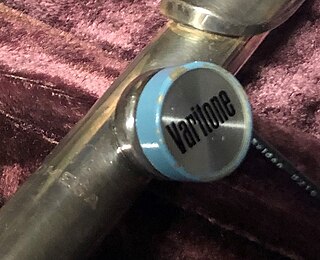
The Varitone was a woodwind pickup and effects unit, allowing direct amplification of the instrument and the introduction of various electronic effects. It was marketed in 1967 by the Selmer Company, which developed units for flute, saxophone, and clarinet. The system included an integrated pickup microphone and a control box which allowed the player to use effects such as tremolo, basic EQ, simultaneous sub-octaves and echo in conjunction with a purpose built amplifier. The ceramic microphone was developed to withstand high sound pressure and moisture levels, and built into the head joint of the flute, the neck-joint of the saxophone, and the barrel joint of the clarinet. The pickup was wired to a preamplifier and control box which was either mounted to the bottom key guard, clipped to the player's belt, or hung on a cord around the players neck.

Saxophone technique refers to the physical means of playing the saxophone. It includes how to hold the instrument, how the embouchure is formed and the airstream produced, tone production, hands and fingering positions, and a number of other aspects. Instrumental technique and corresponding pedagogy is a topic of much interest to musicians and teachers and therefore has been subjected to personal opinions and differences in approach. Over the course of the saxophone’s performance history, notable saxophonists have contributed much to the literature on saxophone technique.

The Tender Storm is an album by American jazz saxophonist Eddie Harris recorded in 1966 and released on the Atlantic label.

The Electrifying Eddie Harris is an album by American jazz saxophonist Eddie Harris recorded in 1967 and released on the Atlantic label.

Plug Me In is an album by American jazz saxophonist Eddie Harris recorded in 1968 and released on the Atlantic label. The title is a reference to Harris's use of a Varitone device to electronically amplify and process his saxophone.
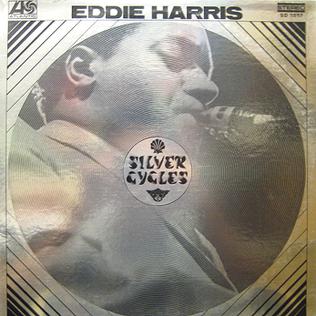
Silver Cycles is an album by American jazz saxophonist Eddie Harris recorded in 1968 and released on the Atlantic label. The album features heavy Latin jazz and postbop themes, accompanied by electronic processing.

Live at Newport is a live album by American jazz saxophonist Eddie Harris recorded at the Newport Jazz Festival in 1970 and released on the Atlantic label.

Eddie Harris Sings the Blues is an album by American jazz saxophonist Eddie Harris recorded in 1972 and released on the Atlantic label.

Is It In is an album by American jazz saxophonist Eddie Harris recorded in 1973 and released on the Atlantic label. It reached number 100 on the Billboard 200 chart.
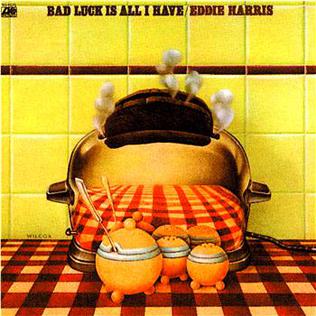
Bad Luck Is All I Have is an album by American jazz saxophonist Eddie Harris recorded in 1974 and 1975 and released on the Atlantic label.
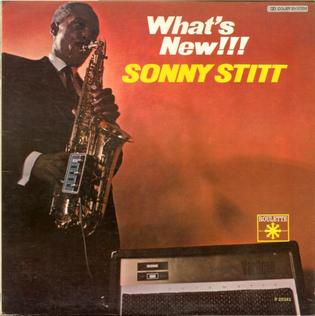
What's New!!! is an album by saxophonist Sonny Stitt recorded in 1966 and released on the Roulette label. The album represents Stitt's first recorded use of the varitone, an electronic amplification device which altered the saxophone's sound.
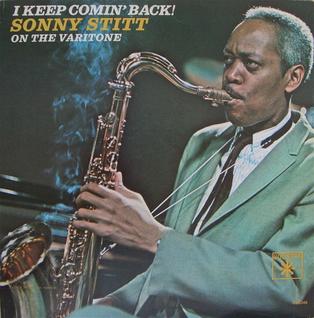
I Keep Comin' Back! is an album by saxophonist Sonny Stitt recorded in 1966 and released on the Roulette label. The album represents Stitt's second album featuring the varitone, an electronic amplification device which altered the saxophone's sound.

Parallel-a-Stitt is an album by saxophonist Sonny Stitt recorded in 1967 and released on the Roulette label. The album represents Stitt's third featuring the varitone, an electronic amplification device which altered the saxophone's sound.

I'm Tired of Driving is an album by saxophonist/pianist Eddie Harris recorded in 1978 and released on the RCA label.

















